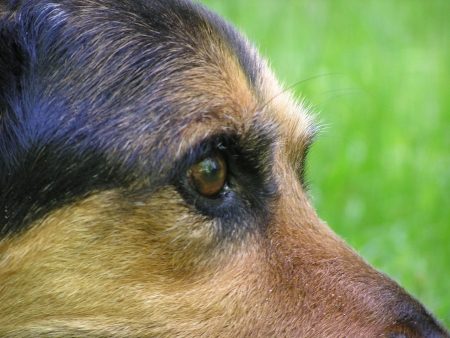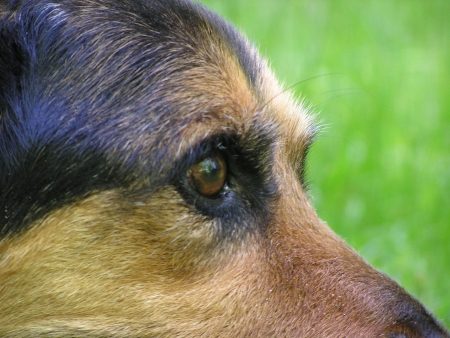

Consequences
Dog sits, gets a cookie. Consequence. Learning occurs.
Dog in yard barks at person walking by; person keeps going. Dogs thinks she made person go away. Consequence. Learning occurs.
Dog walks over to another dog tied out at café. Café dog bites friendly dog on nose. Consequence. Learning occurs.
These three learning
examples differ in interesting ways, though in each, learning occurs,
and the dog adapts her behavior accordingly. Which do you think had the most profound and lasting effect?
In my opinion, the third example is the one I’d say had the most profound effect on our poor girl. In only one event, she has been convinced that approaching an unknown canine is a bad idea (whether true or not). She’ll
be tentative around other strange dogs for a good while, unless her
owner works diligently on socialization, and on preventing future
aggressive occurrences. Unfortunate but true; trauma teaches.
Is there something in this that loving dog owners can learn from, and perhaps use in training and interacting with their dogs? I think so.
Life for mammals often involves choices, and consequences. Sometimes
a poor choice is followed by an unfortunate result: a kid touches a hot
stove, a dog sniffs out a rattler, an impala lingers too long at the
watering hole. Better choices, such as waiting for the walk sign, coming when called, or staying with the herd, are rewarded. It’s life.
Both positive and negative choices teach and shape behaviors, provided the subject is allowed to experience the consequences. And of course, provided that those consequences do not harm the subject. Notice I did not say "affect" the subject. Life stressors can not only be healthy, but also necessary to the development of confidence, and self-motivation.
Dog examples? Let me again turn to my best subject, Lou, the star of Last Dog On The Hill. The
first six months of his life were spent feral, eating squirrels,
garbage and slugs, and socializing with a pack of like-minded,
swashbuckling mutts in the hills of Mendocino, California. These
early stressors had the interesting result of creating a dog with a
sophisticated social sense- much more so than dogs we normally own,
whose canine socialization period often amounts to eight weeks with
mother and littermates, and then random trips to the dog park. Lou
benefitted from this period, and was able to use it later in life when
he became my training partner, helping me to rehabilitate extremely
aggressive, antisocial dogs. He knew social limits, and
understood posture, scent, eye contact, bluff charges, power, and real
intent like no dog I’ve ever known, due in great part to his early need
to survive with a pack of like-minded opportunists. Trial by fire; he experienced stressors that, far from hampering him, made him smarter, and more adaptable.
I don’t prescribe to one limiting theory of dog training. Dogs are smart and versatile, and require us to be as flexible as they are regarding training techniques. What works for a shy border collie won’t for a hulking, dominant Rottweiler; one must adapt according to the situation. But if I were to claim one prevailing common theme in what I do, it would be what I call ‘Be the Dog."
Dogs are not humans, and
shouldn’t treated as such; the errors of anthropomorphizing in training
are in my opinion counter-productive, and unfortunately more and more
common today. Unearned praise, consoling a dog through a
fearful event, masking or delaying engrained misbehaviors with food,
ignoring bad habits- these are mistakes owners and trainers make that
lead to confusion, insecurity and often aggression. "Be
the Dog" simply suggests that, instead of trying to turn your dog into a
proxy human, you should instead turn yourself into a proxy dog, and try
to see things from a canine point of view. We can endeavor to do this, because our brains allow abstraction. Theirs do not; they simply cannot think like a human, even if some of them come mighty close.
If we accept this premise, then we must ask: how do dogs teach each other? Do they experience consequences? Do they have both good and bad experiences on their own, and if so, are these ever beneficial for them?
Anyone who has watched eight or ten dogs together in a field knows the answer to that question. Of course they learn from each other. They
experience (and generate) both positive and negative events, most of
which at some level become instructive, and behavior-changing. Hierarchical posturing, covetous behaviors, play, fear, bonding, sexual behavior- so much goes on between them. Leave a group alone for ten minutes and by and large they will school each other nicely. And
there is negative as well as positive; they nip, growl, steal, bluff
charge, covet- lots of what we would define as "negative" behavior. That they learn from these as efficiently as they do a pat on the head means something.
I want the dogs I train to think of me as a beneficent, elder dog. If one of them jumps up on me, I am not going to turn away, hoping that this action will over time extinguish the behavior. It won’t, for a number of reasons. First,
the dog isn’t doing it for love and attention as much as she is doing
it to set the tone of the relationship; it’s a classic greeting posture
dogs use on each other all the time, to establish position and status. Yes; though dogs are not wolves, they do work out hierarchical arrangements. If you simply turn away, what has the dog learned? She will simply do it again to someone else, further reinforcing the behavior. And
turning away is interpreted by the dog as a submissive move, which
again serves perfectly in her quest to attain status and control. All perfectly normal desires in a dog’s mind.
I teach "sit-to-greet" to
most dogs; it’s a civil, non-threatening, alternative posture, rewarded
by a pat on the head, a click, a treat, or a smile. But
if a dog I don’t know, say a burly American bulldog or a heavy
retriever, jumps up on me, that is disrespectful in a doggish sense, so I
make it plain to the dog that it’s unacceptable. Just as another dog would. He must understand the consequence.
I might use any number of
direct techniques- holding the front paws for ten seconds while calmly
discussing the weather with the dog usually works well- or if necessary a
hip bump combined with authoritative tone and body posture. I
might even casually step on the dog’s leash as it approaches me; if it
jumps up it corrects itself, and almost always defaults into to a
sitting or standing position, at which point I praise and reward
mightily. But at no point am I under the illusion that there cannot be any level of contention between us. Dogs contend naturally; so sometimes must we if we are to alter behavior and mindset. Turning away from a jumper, if anything, reinforces the behavior. Concurrently
with these direct methods, I teach the acceptable alternative-
"sit-to-greet," so the dog has a suitable, healthy option.
Contention of this type does not mean I tolerate "harm." Old
school types who injure dogs to mold behavior are in my opinion simply
redirecting their frustrations onto their hapless canines. Unless a dog is trying to injure or kill me, I’m not going to use derisive means, which create fear and unreliability.
Don’t be afraid to allow your dog to experience the consequences of bad behavior. He’s trained to stay off your bed but jumps up on it anyway? It’s okay to put your third grade school teacher’s face on and order him off. He jumps up on and knocks over an elderly neighbor even though he knows that jumping is a no-no? You can certainly be authoritative and cross with him, because it’s a natural canine expression. Your dog growls at a visiting friend who moves a dog toy off the sofa? Not acceptable; if you catch him in the act, it is the most natural thing in the world to let him know that he’s out of bounds on that one.
A well trained dog is not one who simply does what you want it to do through cajoling, bribery and slight of hand. That dog is still doing what he wants; you have simply adjusted his behavior and expectations to match what you want him to do. A well trained, well-adjusted dog is one who may want to do one thing, but decides to do another because he knows that is what you want him to do. He makes that conscious choice, because he respects you and trusts in your judgment, and not because he fears you. That
dog is thinking and deciding instead of reacting; he understands
consequences, and is able to draw upon them to reason out what is the
best course of action. It’s what dogs are best at, if only we’d give them that chance.
Join the newsletter and never miss out on dog content again!
"*" indicates required fields
By clicking the arrow, you agree to our web Terms of Use and Privacy & Cookie Policy. Easy unsubscribe links are provided in every email.